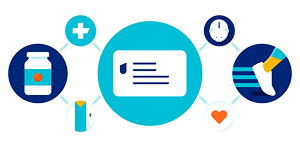You probably grew up eating peanut butter and jelly sandwiches in the school cafeteria. But chances are, your kids might not — and it’s not because there’s a worldwide PB&J shortage. It’s because peanuts are among the most common and potentially harmful allergy-causing foods for children.
Why are food allergies such a big deal? When you’re allergic to a food, your body’s immune system reacts to certain proteins in it, which can lead to mild symptoms, such as hives, or life-threatening ones, such as breathing problems and shock.
But peanuts are only 1 type of food that can potentially cause reactions in children. Besides peanuts, the other top food allergens among children are:
- Cow’s milk
- Soy
- Eggs
- Wheat
- Tree nuts
- Shellfish
- Fish
The threat of food allergies among children has become so serious that food companies now have to indicate on their packaging whether the food inside contains any of those allergens. In April 2021, the Food Allergy Safety, Treatment, Education, and Research (FASTER) Act became law, naming sesame as the 9th major food allergen. (Beginning in January 2023, food manufacturers will also have to list a warning about sesame on their products’ packaging.)
While relatively rare, food allergies still affect millions of American children. Nearly 5% of children under the age of 5 have a food allergy.
In this article you can learn about food allergies and ways you can keep your children safe.
Need health insurance? Call a licensed insurance agent at 1-800-273-8115 or browse available options on uhone.com.
Ready to explore insurance plans where you live?
Why are food allergies so much more common in kids than they used to be?
If it seems like more and more of your friends’ kids have food allergies these days, you’re not imagining things. Food allergies have become twice as common in the past 20 years, says David Stukus, M.D., a spokesperson for the American College of Allergy, Asthma & Immunology and a professor of clinical pediatrics. But there is also no single reason behind the rise, he adds.
That said, there are some clues. “We know that the tendency to develop allergies is inherited, so children born to parents with allergies are more likely to develop allergies,” says Dr. Stukus. He’s also the director of the Food Allergy Treatment Center at Nationwide Children’s Hospital and the Ohio State University College of Medicine in Columbus. Another possibility could be the result of what is known as the “hygiene hypothesis,” he says, which “has demonstrated that shifts from rural farming environments to more urban and cleaner environments is associated with increased risk of allergies.”
What appears to help: “We now know that early introduction, starting at 4 to 6 months of age and ongoing inclusion in the diet is the best strategy to prevent food allergies,” says Dr. Stukus.
What might your child’s food allergy symptoms look like? They can turn up in or on the following parts of your child’s body:
- Skin (itching, hives, redness, swelling)
- Stomach (cramps or pain, nausea, vomiting, diarrhea)
- Eyes (tearing, redness, itching and swelling)
- Airway (throat itching or tightness, trouble breathing, shortness of breath, wheezing, coughing)
Can children outgrow certain food allergies?
The simple answer is yes. Most children will outgrow their food allergies, so your kid might start tolerating foods they were originally allergic to after the age of 3 or 4. Some even better news: Anywhere from 80% to 90% of a child’s allergies to egg, milk, soy and wheat disappear by the time they’re 5 years old.
But only about 20% of children with peanut, tree nut or seafood allergies will develop a tolerance over time, Dr. Stukus says.
So, it’s a good idea to consult your child’s doctor or allergist before introducing any new foods into their diet. Their doctor may give them an oral test to figure out whether they’re allergic. Normally, that involves giving them a small amount of a particular food that might trigger an allergy, then closely monitoring them for an allergic reaction.
Why are food allergies so serious?
The increase in the number of children suffering from food allergies has made life a little less predictable for some parents, and it’s a cause of serious concern for many others. That’s because food allergies in children can be life-threatening, says Dr. Stukus.
In some children, in addition to having an allergic response to a particular food, there may be other contributing factors that increase their risk of a severe reaction. “For instance, someone with a milk allergy may have mild symptoms like hives, but if they exercise soon after eating, their reaction could be more severe,” says Dr. Stukus.
Some allergic reactions can occur within a few minutes or as gradually as 2 hours, with symptoms ranging from rashes or hives (mild) to anaphylaxis, which can get in the way of a person’s breathing, blood pressure and heart rate — and could be fatal.
Looking for a health plan that may cover a trip to the doctor or to the hospital? Call a licensed insurance agent at 1-800-273-8115 or search uhone.com for available plans.
What can you do to prevent an allergic reaction in your child?
You don’t have to have a degree in medicine to be vigilant and make things safer for your child if they’re dealing with a potentially harmful food allergy. Here are some tips to keep in mind:
- Read food labels and avoid giving your child meals that contain the allergen. “We educate families with food allergies on how to read labels to avoid their allergen,” says Dr. Stukus. “And then, depending on what food it is necessary to avoid, we discuss common hidden sources that they may not think of, such as fish in Worcestershire sauce or egg in meringue.”
- Show your child how to help manage their food allergies in an age-appropriate way, says Melanie Carver, chief mission officer of the Asthma and Allergy Foundation of America (AAFA). Carver also launched AAFA’s asthma and allergy patient support community (aafa.org) in 2016. “You can start teaching your child, even at a young age, what allergies they have, and when they’re old enough, teach them to read labels,” she says. “Also, when they’re old enough, teach your child how and when to use self-injectable epinephrine and how to tell an adult if they’re having an allergic reaction.”
Always ask about the ingredients in foods that other people make for your child, says Carver. And wash your hands with soap and water before handling safe food.
- It’s important to keep a list of where your child might be served other foods, whether it be at school, summer camp or a friend’s house. It’s a good idea to alert school officials, camp counselors, and your child’s friends’ parents that they have an allergy. Consider sending your child to these places with their own snacks, and make sure the adults know where their epinephrine (aka adrenaline) auto-injector is and how to use it.
What can you do to treat an allergic reaction in your child?
An allergic reaction can be scary for both your child and you. But it’s good to be prepared, no matter what the situation involves. Here are a few treatment tips:
- Be aware of the potential for life-threatening reactions and know when and how to use an injection of epinephrine, a prescription medication that’s used to treat severe allergic reactions. It’s injected into the person having the reaction using an epinephrine auto-injector, and you’ll want to have doses in your house in a convenient location. For added safety, make sure your child’s school nurse has an epinephrine auto-injector on hand in case of emergency.
- Ask your doctor what you can do to help protect your child from severe allergic reactions if they accidentally eat a food they’re allergic to. One approach is called oral immunotherapy. “This involves carefully giving them small amounts of the allergen under the supervision of an allergist,” explains Dr. Stukus. “It requires careful understanding of risks, benefits, expected outcomes, and the daily regimen involved.” Oral immunotherapy does not cure food allergies in most children, says Dr. Stukus, but it can be a way for them to avoid a severe reaction.
Of course, it’s always a good idea to consult your child’s doctor or allergist about any additional questions you may have about their allergies or potential reactions. And your pharmacist can provide important information about how to use the prescription drugs mentioned above.
Bottom line: Your goal as a parent is keeping your child happy and healthy, so taking the proper precautions and knowing what to do to prevent potential health issues could be just what the doctor — and your child — ordered.
A health insurance plan can be part of a healthy lifestyle. Call a licensed UnitedHealthcare agent at 1-800-273-8115 or explore uhone.com for more information.
This advertisement contains information compiled by UnitedHealthcare. UnitedHealthcare does not represent that these are statements of fact. Please consult directly with your primary care physician if you need medical advice.
UHOKIDALLERGYA1-0123
Sources:
American College of Allergy, Asthma, & Immunology. “Food Allergy.” Retrieved December 20, 2022, from https://acaai.org/allergies/allergic-conditions/food/
HealthyChildren.org. “Food Allergies in Children?” Retrieved December 20, 2022, from https://www.healthychildren.org/English/healthy-living/nutrition/Pages/Food-Allergies-in-Children.aspx
MedlinePlus. November 15, 2018. “Epinephrine Injection.” Retrieved from https://medlineplus.gov/druginfo/meds/a603002.html
University of Rochester. “Food Allergies.” Retrieved December 20, 2022, from https://www.urmc.rochester.edu/childrens-hospital/allergy/food-allergy-center/food-allergies.aspx
U.S. Food & Drug Administration. April 18, 2022. “Food Allergies.” Retrieved from https://www.fda.gov/food/food-labeling-nutrition/food-allergies











